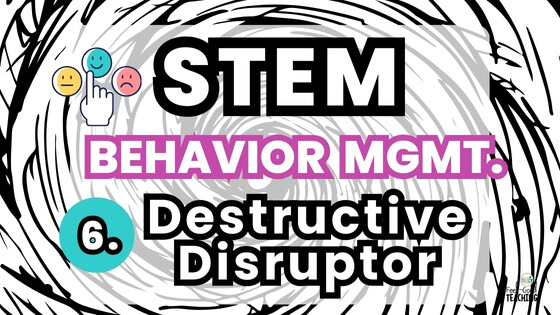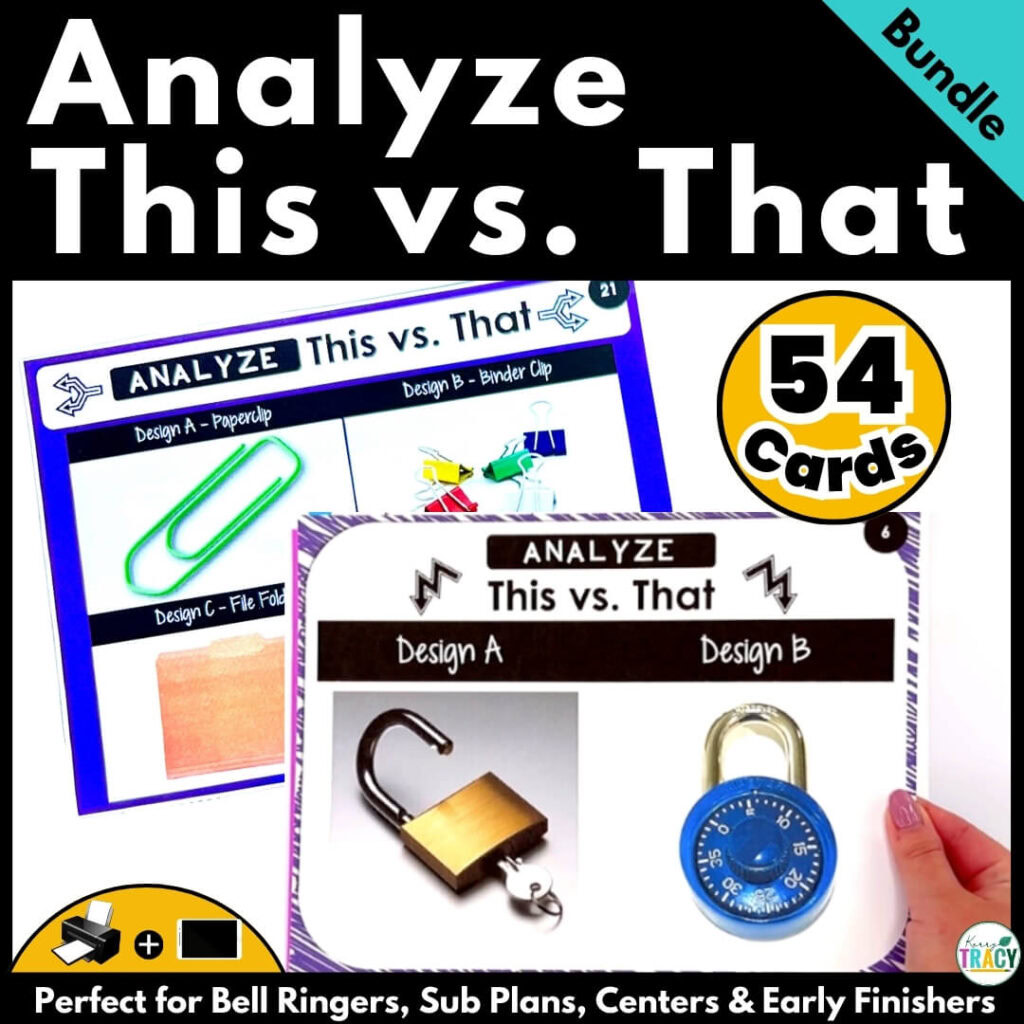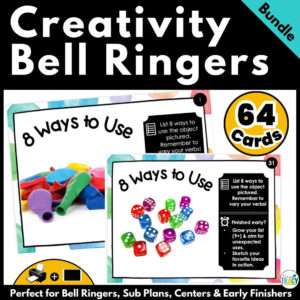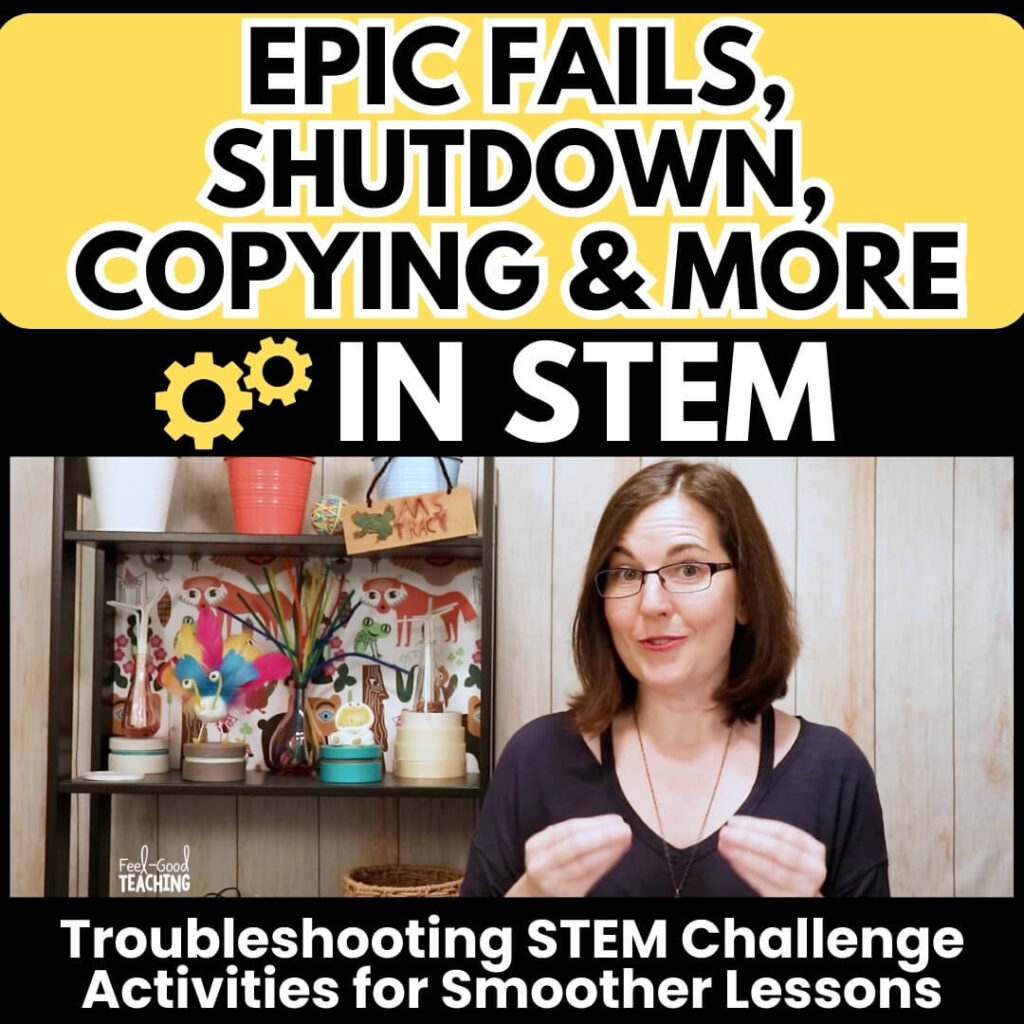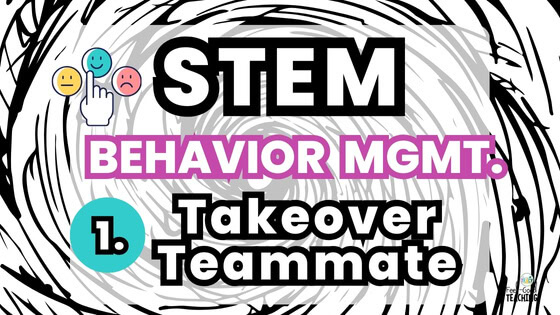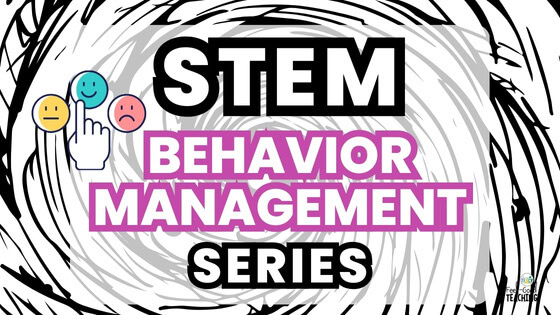We’ve talked about takeover teammates, silent contributors, team disagreements, and distracted groups. But today’s post tackles a challenge that can shake the classroom energy more than any other: The Destructive Disruptor.
This student might knock over group structures, throw materials, intentionally break supplies, or engage in off-task behavior that pulls attention from everyone else.
The behavior can feel personal, frustrating, and impossible to manage when it happens in the middle of a hands-on STEM activity.
But behind most disruptive behavior is unmet need, miscommunication, or lack of structure. So let’s walk through strategies to anticipate, manage, and turn around the toughest moments — without losing your cool or your momentum.
This post is part of the STEM Classroom Management Blog Series!
Meet the Destructive Disruptor
This student doesn’t just get distracted. They derail the entire challenge. They might:
- Knock over teammates’ builds
- Break materials, intentionally or through carelessness
- Yell or make loud noises at inappropriate times
- Roughhouse or invade personal space
- Disrupt others through aggressive or chaotic behavior
While the Distracted Group tends to veer off-task due to excitement or lack of structure, the Destructive Disruptor crosses a line putting safety, materials, or the emotional tone of the group at risk.
Why Destructive Behavior Happens in STEM
Destruction and disruption are often symptoms of deeper issues. A student may act out because:
- They feel overwhelmed or dysregulated (noise, movement, or social stressors)
- They want attention or control in a chaotic environment
- They don’t know how else to engage with peers
- They’re testing boundaries, especially if they’ve experienced inconsistent ones before
- They’re struggling with emotional regulation or impulse control
It’s not always malicious, but it still requires clear, immediate response. STEM should feel safe, purposeful, and joyful. That means we need to protect learning space and build in support for everyone.
Strategies for Managing Destructive Destroyers
Here’s how to support disruptors before, during, and after a challenge.
🌍 Before the Challenge: Prepare & Prevent
1️⃣ Review expectations clearly
- Set and model specific norms for behavior, voice level, movement, and material use.
- Role-play examples of respectful vs. disruptive behavior.
2️⃣ Pre-teach calming strategies
- Use check-in routines to help students assess how ready they are to engage.
- Teach breathing exercises, fidgets, or movement breaks for regulation.
- Create an opt-in calm-down corner with clear guidelines (e.g., “Sit, breathe, draw, or reflect. Return when you’re ready to participate respectfully.”)
3️⃣ Assign a student helper role
Give potentially disruptive students meaningful responsibility (supply manager, team communicator, etc.) to channel energy positively.
4️⃣ Set clear boundaries with compassion
Say:
“I want everyone in this challenge., but we need to protect each other’s space, materials, and ideas. If anyone isn’t able to do that today, I have an alternate assignment ready.“
Make sure you have alternate activities ready. An empty threat here will do more harm than good. You’ll find some materials-free STEM activities at the end of this post.
5️⃣ Provide scaffolds for impulse control
- Use visual timers, team progress charts, or build checkpoints. (See last post for more.)
- Give reminders like: “Wait for the signal before you build. Hands off materials until everyone is ready.”
6️⃣ Limit materials until students show readiness.
Keep supplies at the front of the room. Distribute them only when teams have a plan or sketch to show they’re ready to build.
Or try this pro tip sent in by educator, Leslie Black:
“I wanted to share a tip I use to keep students from being distracted until we are ready to use the materials. I have canvas drop cloths or tablecloths covering up the materials until we are ready to use them. It’s really helped my students focus on listening to the directions before we start.”
⏱️ During the Challenge: Monitor, Redirect & Stay Calm
📌 Use proximity and nonverbal cues
Stay near potential disruptors. Use gentle reminders (pointing to a behavior chart, eye contact, hand signal) before speaking aloud.
📌 Intervene early, quietly, and firmly
If a student starts to escalate, approach calmly and redirect:
“It looks like you’re having a hard time right now. Let’s take a quick reset so you can rejoin safely.”
📌 Don’t allow damage to continue
If a student is repeatedly harming builds or materials, remove them from that part of the activity with dignity. Redirect to a parallel task: observation, note-taking, design drawing, or materials-free STEM activities.
📌 Reframe frustration
Help students name what they’re feeling:
“You seem frustrated with your build. Let’s take a break and talk about what’s not working.”
I have a short training on helping students persevere when they’re frustrated that could be helpful. It has a full script for handling situations where students self-sabotage.
📌 Remove and provide alternate STEM assignment
If short breaks don’t correct the behavior, it’s time to remove. Try framing this as a support rather than a punishment.
📌 Use buddy systems or support staff when needed
If a student poses a safety risk, of course call in additional help or enact a pre-determined behavior plan.
🔄 After the Challenge: Repair & Rebuild
⭐️ Debrief calmly and privately
- Ask: “What happened? What were you feeling? What do you think should happen next?”
- Stay curious, not accusatory.
⭐️ Encourage reflection and responsibility
Use reflection sheets or a “STEM behavior think space” where students can write/draw:
- What did I do?
- Who was affected?
- What can I do to repair it?
⭐️ Offer a pathway back in
Say:
“I believe you can handle the next challenge better. Let’s talk about what will help you succeed.”
⭐️ Use logical consequences
Instead of punitive action, assign restorative steps:
- Rebuild what was damaged
- Write a team apology
- Create a “design fix” to replace broken parts
⭐️ Celebrate growth—even small steps
Praise positive participation next time, even if it’s imperfect.
“You were a helpful teammate for 15 minutes straight. That’s huge!”
⭐️ Keep giving fresh starts.
Let students know one bad challenge doesn’t define them. You believe they can grow, and your actions show it.
🧠 Key Takeaways
- Destructive behavior often masks deeper needs: dysregulation, confusion, frustration, or the desire for connection.
- You can protect the group experience without excluding the student indefinitely.
- Clear boundaries + consistent structure + compassion = your best path forward.
💡 Want a Free STEM Classroom Management Handbook?
I’m putting together a printable copy of these strategies as well as navigating other tricky STEM behaviors perfect for keeping in your lesson planner or sharing at your next PLC or team meeting. It will be sent to every subscriber on my email list when the series is complete. Sign up below to get on the list.
Looking for Materials-Free STEM Activities?
Any of these work well as an alternative, materials-free assignment.
Need More Support?
✨ Next in the Series…
What happens when a student in the group checks out completely and says, “I don’t care”? In our next post, we’ll explore The Apathetic Student.
Explore all posts in the STEM Classroom Management Series here.
Pin it. Share it. Save it. Let’s build better teams, one STEM challenge at a time. 🚀
Let’s make space for every student to contribute with confidence — even the ones still learning how.


